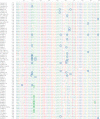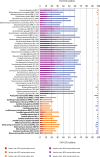Molecular phylogeny of sequenced Saccharomycetes reveals polyphyly of the alternative yeast codon usage
- PMID: 25646540
- PMCID: PMC4986446
- DOI: 10.1093/gbe/evu152
Molecular phylogeny of sequenced Saccharomycetes reveals polyphyly of the alternative yeast codon usage
Abstract
The universal genetic code defines the translation of nucleotide triplets, called codons, into amino acids. In many Saccharomycetes a unique alteration of this code affects the translation of the CUG codon, which is normally translated as leucine. Most of the species encoding CUG alternatively as serine belong to the Candida genus and were grouped into a so-called CTG clade. However, the "Candida genus" is not a monophyletic group and several Candida species are known to use the standard CUG translation. The codon identity could have been changed in a single branch, the ancestor of the Candida, or to several branches independently leading to a polyphyletic alternative yeast codon usage (AYCU). In order to resolve the monophyly or polyphyly of the AYCU, we performed a phylogenomics analysis of 26 motor and cytoskeletal proteins from 60 sequenced yeast species. By investigating the CUG codon positions with respect to sequence conservation at the respective alignment positions, we were able to unambiguously assign the standard code or AYCU. Quantitative analysis of the highly conserved leucine and serine alignment positions showed that 61.1% and 17% of the CUG codons coding for leucine and serine, respectively, are at highly conserved positions, whereas only 0.6% and 2.3% of the CUG codons, respectively, are at positions conserved in the respective other amino acid. Plotting the codon usage onto the phylogenetic tree revealed the polyphyly of the AYCU with Pachysolen tannophilus and the CTG clade branching independently within a time span of 30–100 Ma.
Figures






Corrected and republished from
- previous manuscript
Similar articles
-
Molecular phylogeny of sequenced saccharomycetes reveals polyphyly of the alternative yeast codon usage.Genome Biol Evol. 2014 Jul 22;6(5):evu093. doi: 10.1093/gbe/evu093. Epub 2014 Jul 22. Genome Biol Evol. 2014. Retraction in: Genome Biol Evol. 2014 Apr 30;6(5):1253. doi: 10.1093/gbe/evu093. PMID: 25053656 Retracted.
-
Predicting the fungal CUG codon translation with Bagheera.BMC Genomics. 2014 May 29;15(1):411. doi: 10.1186/1471-2164-15-411. BMC Genomics. 2014. PMID: 24885275 Free PMC article.
-
Non-universal decoding of the leucine codon CUG in several Candida species.Nucleic Acids Res. 1993 Aug 25;21(17):4039-45. doi: 10.1093/nar/21.17.4039. Nucleic Acids Res. 1993. PMID: 8371978 Free PMC article.
-
Codon reassignment in Candida species: an evolutionary conundrum.Biochimie. 1996;78(11-12):993-9. doi: 10.1016/s0300-9084(97)86722-3. Biochimie. 1996. PMID: 9150877 Review.
-
The non-standard genetic code of Candida spp.: an evolving genetic code or a novel mechanism for adaptation?Mol Microbiol. 1997 Nov;26(3):423-31. doi: 10.1046/j.1365-2958.1997.5891961.x. Mol Microbiol. 1997. PMID: 9402014 Review.
Cited by
-
Endogenous Stochastic Decoding of the CUG Codon by Competing Ser- and Leu-tRNAs in Ascoidea asiatica.Curr Biol. 2018 Jul 9;28(13):2046-2057.e5. doi: 10.1016/j.cub.2018.04.085. Epub 2018 Jun 18. Curr Biol. 2018. PMID: 29910077 Free PMC article.
-
Evolutionary genomics of yeast pathogens in the Saccharomycotina.FEMS Yeast Res. 2016 Sep;16(6):fow064. doi: 10.1093/femsyr/fow064. Epub 2016 Aug 3. FEMS Yeast Res. 2016. PMID: 27493146 Free PMC article. Review.
-
Development of a Transformation Method for Metschnikowia borealis and other CUG-Serine Yeasts.Genes (Basel). 2019 Jan 23;10(2):78. doi: 10.3390/genes10020078. Genes (Basel). 2019. PMID: 30678093 Free PMC article.
-
Survival Strategies of Pathogenic Candida Species in Human Blood Show Independent and Specific Adaptations.mBio. 2020 Oct 6;11(5):e02435-20. doi: 10.1128/mBio.02435-20. mBio. 2020. PMID: 33024045 Free PMC article.
-
Comparative genomics of biotechnologically important yeasts.Proc Natl Acad Sci U S A. 2016 Aug 30;113(35):9882-7. doi: 10.1073/pnas.1603941113. Epub 2016 Aug 17. Proc Natl Acad Sci U S A. 2016. PMID: 27535936 Free PMC article.
References
Publication types
MeSH terms
Substances
LinkOut - more resources
Full Text Sources
Other Literature Sources

